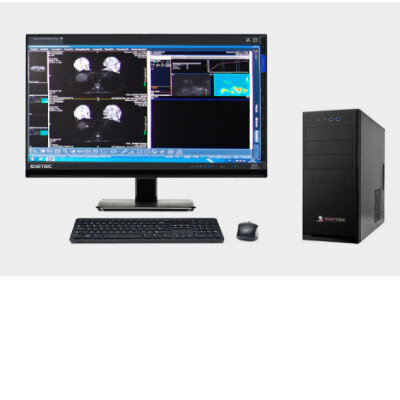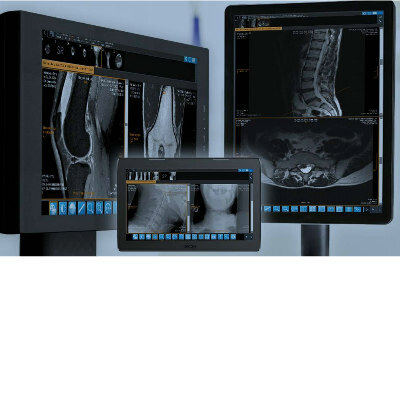AI Fuses CT and MRI Scans for Improved Clinical Diagnosis
|
By MedImaging International staff writers Posted on 30 Jun 2023 |

Computed tomography (CT) imaging uses X-ray technology to take detailed cross-sectional images of the body, which are then converted into a 3D visualization of bone structures that are opaque to X-rays. On the other hand, magnetic resonance imaging (MRI) uses powerful magnetic fields and radio waves to generate precise images of soft tissues such as organs or damaged tissues. Combining these two techniques could offer healthcare professionals a more holistic view of a patient's anatomy, uncovering hidden aspects of their health issues. Now, new research has demonstrated how artificial intelligence (AI) can be utilized to combine images from clinical X-ray CT and MRI scans.
The new method, known as the Dual-Branch Generative Adversarial Network (DBGAN), has been developed by researchers at Queen Mary University of London (London, UK) and Shandong University of Technology (Zibo, China) holds the potential for enabling a clearer and more clinically valuable interpretation of CT and MRI scans. This technique effectively merges the rigid bone structures from the CT scan with the detailed soft tissue imaging from the MRI. This development could enhance clinical diagnosis and patient care for a multitude of conditions where such scans are commonly used but exhibit limitations when utilized separately.
DBGAN is an advanced AI approach based on deep-learning algorithms, featuring a dual-branch structure with multiple generators and discriminators. The generators produce fused images that blend the key features and additional information from CT and MRI scans. The discriminators evaluate the quality of the generated images by comparing them to real images and filtering out lower-quality ones until a high-quality fusion is achieved. This generative adversarial interaction between generators and discriminators enables the efficient and realistic fusion of CT and MRI images, minimizing artifacts and maximizing visual information.
The dual nature of DBGAN includes a multi-scale extraction module (MEM) which focuses on extracting key features and detailed information from the CT and MRI scans and a self-attention module (SAM) which highlights the most relevant and unique features in the fused images. Comprehensive testing of the DBGAN approach has shown its performance to be superior as compared to existing techniques in terms of image quality and diagnostic accuracy. As CT and MRI scans each have their own strengths and weaknesses, the application of AI can help radiographers to synergistically combine both types of scans, maximizing their strengths and eliminating their weaknesses.
Related Links:
Queen Mary University of London
Shandong University of Technology
Latest General/Advanced Imaging News
- New AI Method Captures Uncertainty in Medical Images
- CT Coronary Angiography Reduces Need for Invasive Tests to Diagnose Coronary Artery Disease
- Novel Blood Test Could Reduce Need for PET Imaging of Patients with Alzheimer’s
- CT-Based Deep Learning Algorithm Accurately Differentiates Benign From Malignant Vertebral Fractures
- Minimally Invasive Procedure Could Help Patients Avoid Thyroid Surgery
- Self-Driving Mobile C-Arm Reduces Imaging Time during Surgery
- AR Application Turns Medical Scans Into Holograms for Assistance in Surgical Planning
- Imaging Technology Provides Ground-Breaking New Approach for Diagnosing and Treating Bowel Cancer
- CT Coronary Calcium Scoring Predicts Heart Attacks and Strokes
- AI Model Detects 90% of Lymphatic Cancer Cases from PET and CT Images
- Breakthrough Technology Revolutionizes Breast Imaging
- State-Of-The-Art System Enhances Accuracy of Image-Guided Diagnostic and Interventional Procedures
- Catheter-Based Device with New Cardiovascular Imaging Approach Offers Unprecedented View of Dangerous Plaques
- AI Model Draws Maps to Accurately Identify Tumors and Diseases in Medical Images
- AI-Enabled CT System Provides More Accurate and Reliable Imaging Results
- Routine Chest CT Exams Can Identify Patients at Risk for Cardiovascular Disease
Channels
Radiography
view channel
Novel Breast Imaging System Proves As Effective As Mammography
Breast cancer remains the most frequently diagnosed cancer among women. It is projected that one in eight women will be diagnosed with breast cancer during her lifetime, and one in 42 women who turn 50... Read more
AI Assistance Improves Breast-Cancer Screening by Reducing False Positives
Radiologists typically detect one case of cancer for every 200 mammograms reviewed. However, these evaluations often result in false positives, leading to unnecessary patient recalls for additional testing,... Read moreMRI
view channel
PET/MRI Improves Diagnostic Accuracy for Prostate Cancer Patients
The Prostate Imaging Reporting and Data System (PI-RADS) is a five-point scale to assess potential prostate cancer in MR images. PI-RADS category 3 which offers an unclear suggestion of clinically significant... Read more
Next Generation MR-Guided Focused Ultrasound Ushers In Future of Incisionless Neurosurgery
Essential tremor, often called familial, idiopathic, or benign tremor, leads to uncontrollable shaking that significantly affects a person’s life. When traditional medications do not alleviate symptoms,... Read more
Two-Part MRI Scan Detects Prostate Cancer More Quickly without Compromising Diagnostic Quality
Prostate cancer ranks as the most prevalent cancer among men. Over the last decade, the introduction of MRI scans has significantly transformed the diagnosis process, marking the most substantial advancement... Read moreUltrasound
view channel
Deep Learning Advances Super-Resolution Ultrasound Imaging
Ultrasound localization microscopy (ULM) is an advanced imaging technique that offers high-resolution visualization of microvascular structures. It employs microbubbles, FDA-approved contrast agents, injected... Read more
Novel Ultrasound-Launched Targeted Nanoparticle Eliminates Biofilm and Bacterial Infection
Biofilms, formed by bacteria aggregating into dense communities for protection against harsh environmental conditions, are a significant contributor to various infectious diseases. Biofilms frequently... Read moreNuclear Medicine
view channel
New SPECT/CT Technique Could Change Imaging Practices and Increase Patient Access
The development of lead-212 (212Pb)-PSMA–based targeted alpha therapy (TAT) is garnering significant interest in treating patients with metastatic castration-resistant prostate cancer. The imaging of 212Pb,... Read moreNew Radiotheranostic System Detects and Treats Ovarian Cancer Noninvasively
Ovarian cancer is the most lethal gynecological cancer, with less than a 30% five-year survival rate for those diagnosed in late stages. Despite surgery and platinum-based chemotherapy being the standard... Read more
AI System Automatically and Reliably Detects Cardiac Amyloidosis Using Scintigraphy Imaging
Cardiac amyloidosis, a condition characterized by the buildup of abnormal protein deposits (amyloids) in the heart muscle, severely affects heart function and can lead to heart failure or death without... Read moreImaging IT
view channel
New Google Cloud Medical Imaging Suite Makes Imaging Healthcare Data More Accessible
Medical imaging is a critical tool used to diagnose patients, and there are billions of medical images scanned globally each year. Imaging data accounts for about 90% of all healthcare data1 and, until... Read more
Global AI in Medical Diagnostics Market to Be Driven by Demand for Image Recognition in Radiology
The global artificial intelligence (AI) in medical diagnostics market is expanding with early disease detection being one of its key applications and image recognition becoming a compelling consumer proposition... Read moreIndustry News
view channel
Bayer and Google Partner on New AI Product for Radiologists
Medical imaging data comprises around 90% of all healthcare data, and it is a highly complex and rich clinical data modality and serves as a vital tool for diagnosing patients. Each year, billions of medical... Read more





















